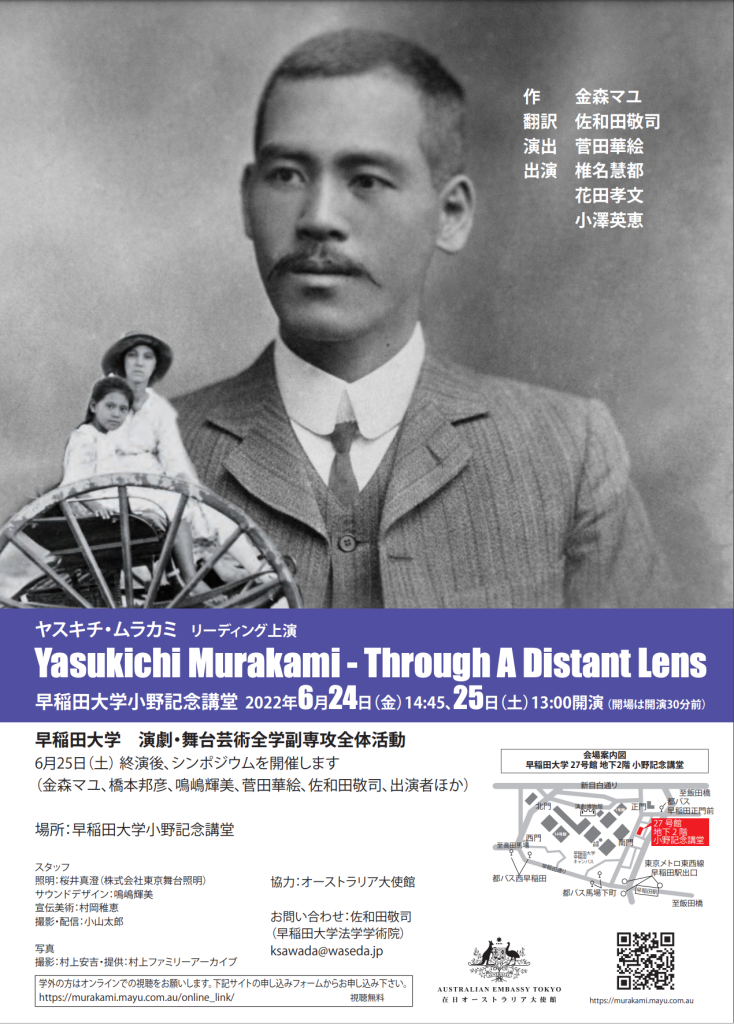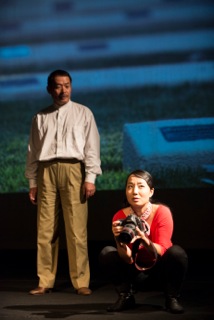
Event Dates:
24 June 2022 (Fri) 2:45pm (JST)
25 June 2022 (Sat) 1pm (JST) – There will be a Symposium after the Reading
*Doors open 30 mins prior
Location:
Waseda University Ono Memorial Auditorium for Waseda University Students and Staff
Online for all other audiences (free online event). Bookings taken here from 1 June 2022
Creative Team
Written by: Mayu Kanamori
Translation by: Keiji Sawada
Directed by: Kae Sugata
Performed by: Keito Shiina, Takafumi Hanada, Hanae Ozawa
Sound Design by: Terumi Narushima
Lighting Design by: Masumi Sakurai (Tokyo Butai ShowMei)
Marketing Design by: Chie Muraoka
Documentation & Streaming: Taro Koyama
Photographs by: Yasukichi Murakami Courtesy, Murakami Family Archives
Symposium Panelists:
Mayu Kanamori, Terumi Narushima, Kuni Hashimoto, Kae Sugata, Keiji Sawada, Keito Shiina, Takafumi Hanada, Hanae Ozawa
Supported by: The Australian Embassy, Tokyo
Keiji Sawada
Professor at Waseda University and winner of the 10th Yoshiko Yuasa Award for Theatre Translations. He is the author of 『オーストラリア先住民とパフォーマンス』(“Australian Indigenous People and Performance”, Tokyo University Press)『現代演劇と文化の混淆』(“Contemporary Theatre and Cultural Hybridity”, Waseda University Press). His translation work include the 『オーストラリア演劇叢書』(“Australian Drama Series” ①~⑭ ,Oceania Press), and more recently, 『ミス・タナカ』 (“Miss Tanaka”, Edo Ito Ayatsuri Ningyo: Youkiza), 『エブリマンとポールダンサーたち』(“Everyman & the Pole Dancers”, Shinjuku Ryozanpaku), 『ジャック・チャールズ vs 王冠』/ “Jack Charles V The Crown ” (Subtitle /Fuji no Kuni ? World Theatre Festival Shizuoka), 『ジャスパー・ジョーンズ』(“Jasper Jones” , Theatre Office Natori) , 『フューリアス~猛り狂う風~』(“Furious”), 『女と男とシェイクスピア』(“Dead White Males”), and 『面と向かって』(“Face to Face”) (Haiyuza), 『聖なる日』(“Holy Day” ) and 『リムーバリスト- 引っ越し屋 – 』(“The Removalists *) (Gekidan Haisho) and other works.
Kae Sugata
Born in Yokohama, graduated from the Department of English Literature, Faculty of Literature, Japan Women’s University. After directing 『マンザナ、わが町』 (Written by Hisashi Inoue; “Manzanar: Our Town”), she joined the Haiyuza Theatre Company’s Theatre Research Institute, and has since directed Australian plays, such as 『ハサミ、紙、石(じゃんけんぽん)』 (written by Daniel Keene, “Scissors, Paper, Rock”; translated by Keiji Sawada) as part of Haiyuza’s Bungei Direction Department’s newcomer presentation, and the Haiyuza Lab Performance of 『フューリアス~猛り狂う風~』(written by Michael Gow, “Furious”; translated by Keiji Sawada). She has also directed 『象』(written by Minoru Betsuyaku; “The Elephant”) at the Minoru Betsuyaku Festival as well as devised and directed Haiyuza Theatre Company’s reading of 『戦争とは…』(“Senso to Wa…. “). She is currently working with Haiyuza Theatre Company’s Department of Bungei (Arts and Literature) Direction.
Mayu Kanamori
Sydney based storyteller working across mediums including theatre, performance, photography, video, installation, heritage interpretation, writing, and documentary making. Her performance works include “The Heart of the Journey”, “CHIKA: A Documentary Performance”, “Yasukichi Murakami: Through a Distant Lens” and “You’ve Mistaken Me For A Butterfly”. Her photographic exhibitions include “Unseen Faces of Japan”, “Sugao no Australia” and “Teiju to wa Nandaro: Australia”. As a heritage interpreter, she has created the audio for Nyamba Buru Yawuru’s multi award winning “Jetty to Jetty Heritage Trail” and “Lustre: Pearling & Australia” with the WA Museum. Other works include “Cowra Voices” in Cowra, NSW and “In Repose”, in Broome, Townsville and on Thursday Island. As a radio producer , she has received a commendation for United Nations Association of Victoria Media Peace Award Promotion of Multicultural Issues, Broome NAIDOC Non Indigenous Reconciliation Award and has been a finalist for Walkley Awards for Excellence in Journalism. She is a board member of The Koto Music Institute of Australia and a member of Nikkei Australia.











